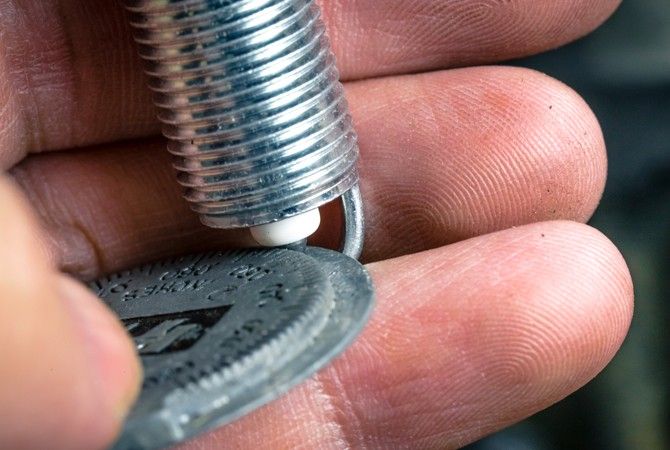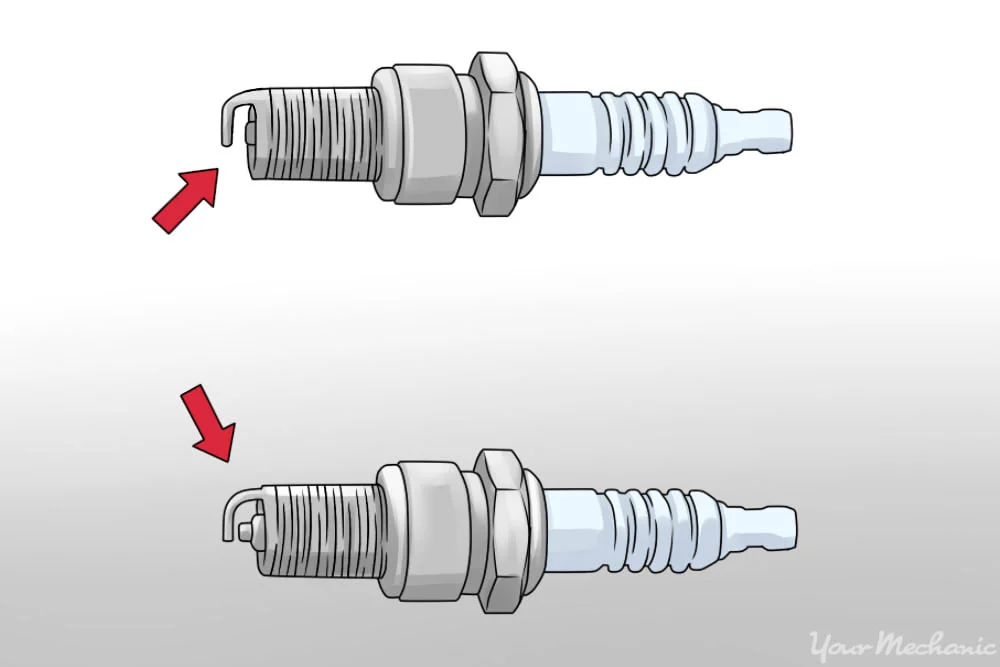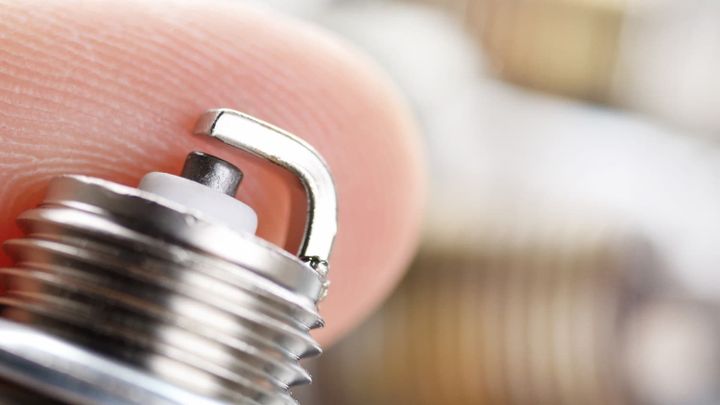


Spark plugs are small yet crucial components in gasoline-powered internal combustion engines. They play a vital role in the engine's ignition system, responsible for igniting the air-fuel mixture within the combustion chamber. Without properly functioning spark plugs, the engine would be unable to generate the power necessary for the vehicle to operate.

Before we dive into the gapping process, let's understand why spark plugs might need to be gapped in the first place. Here are some common scenarios:
| Cause | Description |
|---|---|
| Spark Plug Gap Widening Due to Erosion | Over time, the electrodes of spark plugs can erode, causing the gap to widen beyond the recommended specifications. This erosion is a natural consequence of the extreme heat and electrical stress that spark plugs endure during their service life. As the gap widens, it becomes increasingly difficult for the spark to jump across and ignite the air/fuel mixture properly, leading to misfires and poor engine performance. |
| Improper Gapping from the Factory | While rare, there have been instances where new spark plugs come from the factory with an incorrect gap. This could be due to quality control issues or manufacturing defects. In such cases, the gap needs to be adjusted to the manufacturer's specifications before installation. |
| Accidental Bending of Electrodes | During the process of removing or installing spark plugs, it's possible for the electrodes to get accidentally bent or damaged. This can happen if the tools slip or if excessive force is applied. When the electrodes are bent, the gap is altered, and the spark plug may not function correctly. |
Before attempting to gap your spark plugs, it's crucial to inspect them thoroughly and identify any potential issues. Here's how you can do it:

Remove the spark plugs from the engine.
Visually inspect the condition of the electrodes and the gap using a bright light.
If you have access to a feeler gauge or a gap tool, use it to precisely measure the gap.
During your inspection, look out for the following signs that may indicate a gap issue:
Excessive erosion or rounding of the electrode tips
Bent or damaged electrodes
Gap measurement significantly different from the manufacturer's specifications
While specialized gapping tools are recommended, you can carefully gap spark plugs without one in an emergency. Here's how you can do it:
Refer to your vehicle's manual or the spark plug specifications to determine the correct gap measurement.
Gather a thin metal strip or a feeler gauge (e.g., from a set of feeler gauges) that matches the desired gap thickness.
| Step | Action |
|---|---|
| 1 | Gently insert the metal strip or feeler gauge between the electrodes to check and adjust the gap. |
| 2 | If the gap is too small, carefully pry the ground electrode away from the center electrode using a small flathead screwdriver or needle-nose pliers. |
| 3 | If the gap is too large, gently tap the ground electrode towards the center electrode using pliers or a small hammer on a solid surface. |
| 4 | Recheck the gap after adjusting and repeat the process as needed until the gap is within the specified range. |
Be extremely gentle when adjusting the electrodes to avoid damaging them.
Avoid prying directly against the center electrode, as it is fragile and can easily break.
For fine-wire or precious metal electrodes, it's best to have a professional gap them to prevent damage.
While gapping spark plugs without a tool is possible in emergencies, it's essential to take preventive measures to avoid recurring issues:
Follow the manufacturer's recommended spark plug replacement intervals.
Inspect and gap new spark plugs before installation, even if they are pre-gapped.
Avoid over-tightening or under-tightening spark plugs during installation, as this can cause damage and affect the gap.
Use anti-seize compound on spark plug threads only if recommended by the manufacturer.
| Option | Cost Range | Description |
|---|---|---|
| Gapping Spark Plugs Without a Tool | Risk of Damage | While gapping spark plugs without a tool is a viable option in emergencies, it carries the risk of damaging the plugs if not done carefully. |
| Purchasing a Spark Plug Gapping Tool | $5 - $20 | Purchasing an inexpensive spark plug gapping tool is highly recommended for proper maintenance and to avoid potential engine damage from improper gapping. |
| Professional Spark Plug Replacement | $100 - $350 | If you're not comfortable performing this task yourself or if you suspect more significant issues with your spark plugs, it's advisable to have a professional handle the spark plug replacement. The cost typically ranges from $100 to $350, depending on the vehicle and the number of spark plugs that need to be replaced. |
As a mechanic, I understand the importance of being resourceful and finding solutions even in challenging situations. While gapping spark plugs without a specialized tool requires extreme care and precision, it's a skill that can come in handy when you're in a pinch. However, investing in an affordable gapping tool and following proper maintenance intervals is highly recommended for long-term engine health and performance.
Remember, preventive maintenance is key to avoiding costly repairs and ensuring your vehicle runs smoothly for years to come. If you're ever unsure or uncomfortable with performing any maintenance tasks, don't hesitate to seek professional assistance. Your safety and the longevity of your vehicle should always be the top priorities.
The purpose of gapping spark plugs is to ensure the correct distance between the electrodes for proper ignition of the air/fuel mixture. This gap can widen over time due to erosion, requiring adjustment.
No, you should use a thin metal strip or feeler gauge that matches the desired gap thickness specified by the manufacturer.
Inspect the spark plugs for signs of excessive erosion, bent electrodes, or a gap measurement significantly different from the manufacturer's specifications.
It's not recommended to gap spark plugs with precious metal or fine-wire electrodes without a proper tool, as they are fragile and can easily be damaged.
If the gap is too small, you can carefully pry the ground electrode away from the center electrode using a small flathead screwdriver or needle-nose pliers.
If the gap is too large, you can gently tap the ground electrode towards the center electrode using pliers or a small hammer on a solid surface.
You should only use anti-seize compound on spark plug threads if recommended by the manufacturer for your specific vehicle.
Follow the manufacturer's recommended spark plug replacement intervals to prevent recurring issues and ensure optimal engine performance.
Gapping spark plugs without a proper tool carries the risk of damaging the electrodes if not done carefully and with precision.
If you're not comfortable performing the task yourself or if you suspect more significant issues with your spark plugs, it's advisable to have a professional handle the spark plug replacement.

Sarah isn't your average gearhead. With a double major in Mechanical Engineering and Automotive Technology, she dived straight into the world of car repair. After 15 years of turning wrenches at dealerships and independent shops, Sarah joined MICDOT to share her expertise and passion for making cars run like new. Her in-depth knowledge and knack for explaining complex issues in simple terms make her a valuable asset to our team.












